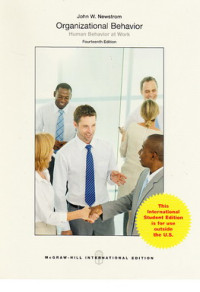Text
Organizational behavior : human behavior at work
Have you had at least part-time experience in some form of business or voluntary orga¬nization? If so, you have quickly learned that not all behavior—whether your own, your manager's, or that of your associates—is entirely rational. And you may have pondered a series of questions about what you saw and felt:
1. Why do people behave as they do at work?
2. How can individuals, groups, and whole organizations work together more effectively
within the increasing pace of corporate change, dramatic restructurings and downsiz-
ings, global recessions, and intense competition?
3. What can managers do to motivate employees toward greater levels of performance?
4. What responsibility do managers have for ensuring employee satisfaction?
5. What can you learn from theory, research, and the experiences of other managers to
help you become an effective future manager?
These and many other questions provide the background for this fourteenth edition of Organizational Behavior: Human Behavior at Work. In the next few paragraphs I will guide you on your journey through this book by providing you with a "roadmap"—an introduction to some of the key topics and methods that form the critical pathway for your learning journey.
Great progress has been made in the field of organizational behavior (OB) in recent years. One long-time observer, after conducting an extensive study, concluded that "a con¬sensus regarding the theoretical knowledge possessed by the field seems to be emerging."1 New theories have appeared on the scene, others have been validated, and some have begun to fade into oblivion. Organizational behavior, while recording great progress, still faces many questions and opportunities for improvement. This book pulls together the best and most current knowledge and provides rich insights into people at work in all kinds of situations and organizations.
One criticism of the OB field is that it has largely ignored the needs of practitioners. By contrast, this book makes a major effort to include numerous examples of real-life work situations, and dozens of these are identified by name. In addition, the chapter-closing "Advice to Future Managers" sections provide extensive lists of practical suggestions that can guide managers for years into the future. The book is characterized by its applied orientation, including a variety of end-of-chapter experiential approaches that encour¬age readers to reflect on what they have read and engage in self-examination. The text is designed to be kept as a reference guide, and it includes 160 action prescriptions for practical guidance (see the summary of managerial prescriptions in Appendix B).
These rules form one powerful basis for a critical managerial skill—that of deductive reasoning. Once you grasp the rule and understand the underlying rationale (theory) for it, you can then derive useful observations and conclusions in a specific situation on your own. (This is a process of moving from the general to the particular.) You can also develop the complementary skill of inductive reasoning, which is combining an observation of an event with a relevant explanation to infer new rules (action prescriptions) for yourself. (This is a process of moving from the particular to the general.) These scientific processes are aided by four skills, as discussed below.
Ketersediaan
Informasi Detail
- Judul Seri
-
-
- No. Panggil
-
658.1 New o
- Penerbit
- New York : Mc Graw-Hill., 2015
- Deskripsi Fisik
-
xx, 556 hal. : il. ; 25 cm.
- Bahasa
-
English
- ISBN/ISSN
-
9781259254420
- Klasifikasi
-
658.1
- Tipe Isi
-
-
- Tipe Media
-
-
- Tipe Pembawa
-
-
- Edisi
-
Ed. XIV
- Subjek
- Info Detail Spesifik
-
-
- Pernyataan Tanggungjawab
-
-
Versi lain/terkait
Tidak tersedia versi lain
Lampiran Berkas
Komentar
Anda harus masuk sebelum memberikan komentar

 Karya Umum
Karya Umum  Filsafat
Filsafat  Agama
Agama  Ilmu-ilmu Sosial
Ilmu-ilmu Sosial  Bahasa
Bahasa  Ilmu-ilmu Murni
Ilmu-ilmu Murni  Ilmu-ilmu Terapan
Ilmu-ilmu Terapan  Kesenian, Hiburan, dan Olahraga
Kesenian, Hiburan, dan Olahraga  Kesusastraan
Kesusastraan  Geografi dan Sejarah
Geografi dan Sejarah